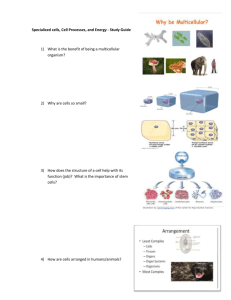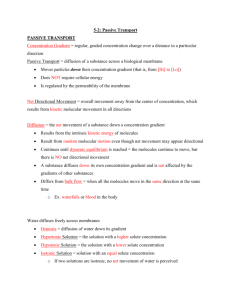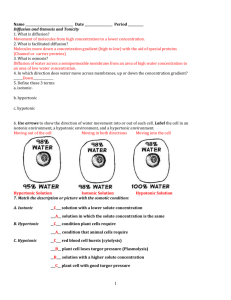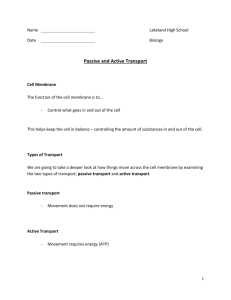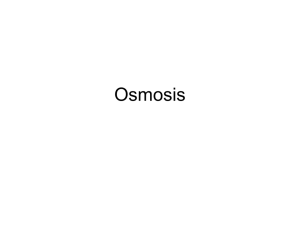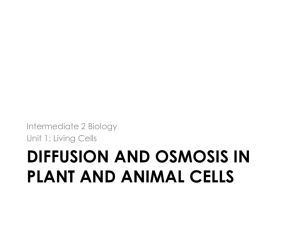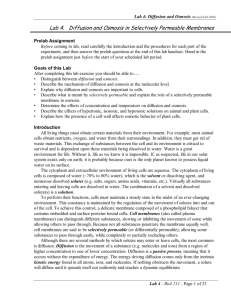Living Cells
advertisement
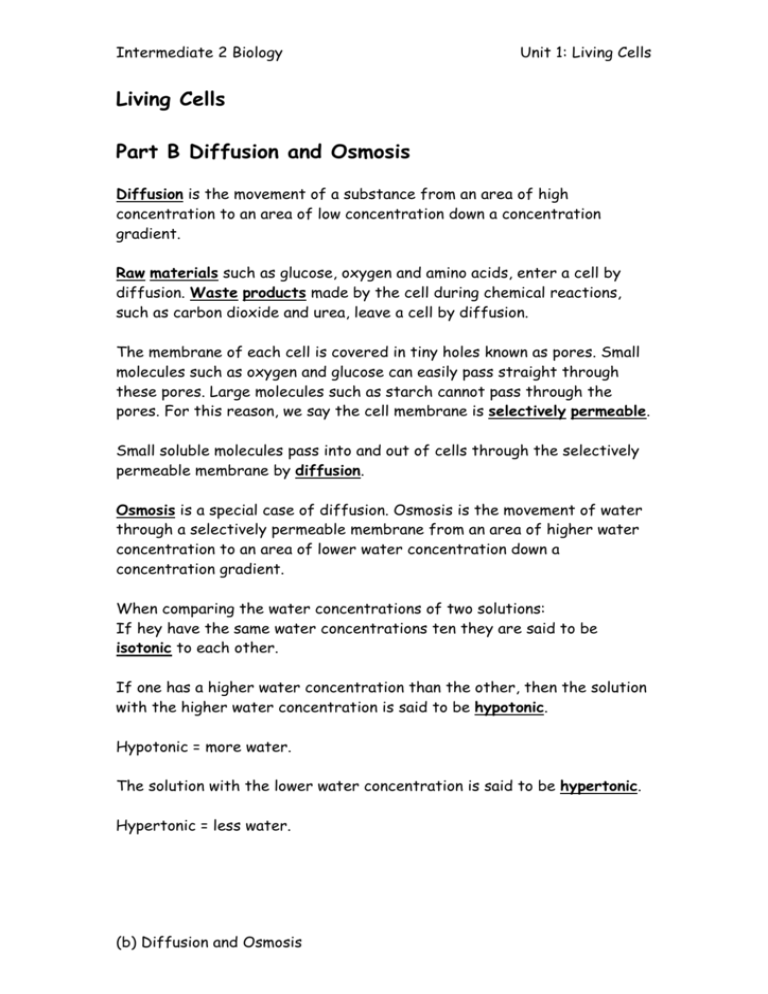
Intermediate 2 Biology Unit 1: Living Cells Living Cells Part B Diffusion and Osmosis Diffusion is the movement of a substance from an area of high concentration to an area of low concentration down a concentration gradient. Raw materials such as glucose, oxygen and amino acids, enter a cell by diffusion. Waste products made by the cell during chemical reactions, such as carbon dioxide and urea, leave a cell by diffusion. The membrane of each cell is covered in tiny holes known as pores. Small molecules such as oxygen and glucose can easily pass straight through these pores. Large molecules such as starch cannot pass through the pores. For this reason, we say the cell membrane is selectively permeable. Small soluble molecules pass into and out of cells through the selectively permeable membrane by diffusion. Osmosis is a special case of diffusion. Osmosis is the movement of water through a selectively permeable membrane from an area of higher water concentration to an area of lower water concentration down a concentration gradient. When comparing the water concentrations of two solutions: If hey have the same water concentrations ten they are said to be isotonic to each other. If one has a higher water concentration than the other, then the solution with the higher water concentration is said to be hypotonic. Hypotonic = more water. The solution with the lower water concentration is said to be hypertonic. Hypertonic = less water. (b) Diffusion and Osmosis Intermediate 2 Biology Unit 1: Living Cells If a cell is placed in a hypertonic solution, there is a higher concentration of water outside the cell. Therefore, water will move into the cell by osmosis. If a cell is placed in a hypertonic solution, there is a higher concentration of water inside the cell. Therefore, water will move out of the cell by osmosis. Plant cells have a strong cell wall surrounding each cell. This strong layer prevents he cell from bursting if it swells and provides mechanical support should the contents of the cell decrease in volume. If a plant cell is places in an isotonic solution there is no net movement of water into or out f the cell. The shape of the cell remains unchanged. If a plant cell is placed in a hypotonic solution there is a net movement of water into the cell. The contents of the cell push up against the cell wall causing the cell to bulge outwards and appear swollen. When the cell bulges we say it has become turgid. If a plant cell is placed in a hypertonic solution, there is a net movement of water out of the cell. The cell vacuole and cytoplasm decrease in volume causing the cell membrane to peel away from the cell wall. When this happens we say that the cell has been plasmolysed and become flaccid. Animal cells do not have a cell wall surrounding their cell membrane. The cell membrane is relatively weak. When placed under pressure, the cell membrane will easily break open. If an animal cell is placed in an isotonic solution there is no net movement of water into or out of the cell. The shape of the cell remains unchanged. If an animal cell is placed in a hypotonic solution there is a net movement of water into the cell. The cell swells and places pressure on the cell membrane, The cell will burst. If an animal cell is placed in a hypertonic solution there is a net movement of water out of the cell. The cell will shrink. (b) Diffusion and Osmosis Intermediate 2 Biology Unit 1: Living Cells Many unicellular organisms do not have a strong cell wall surrounding each cell. If the organism is placed in a hypotonic solution, water will move into the cell by osmosis. There is a risk that the cell may swell enough to cause the membrane to rupture and the cell to burst. Some unicellular organisms contain small vacuoles. The vacuoles take in any additional water that may enter the cell. Once these vacuoles are full, they move to the edge of the cell and empties outside the cell. This allows the cell to control its own water content. This is an example of osmoregulation. (b) Diffusion and Osmosis

